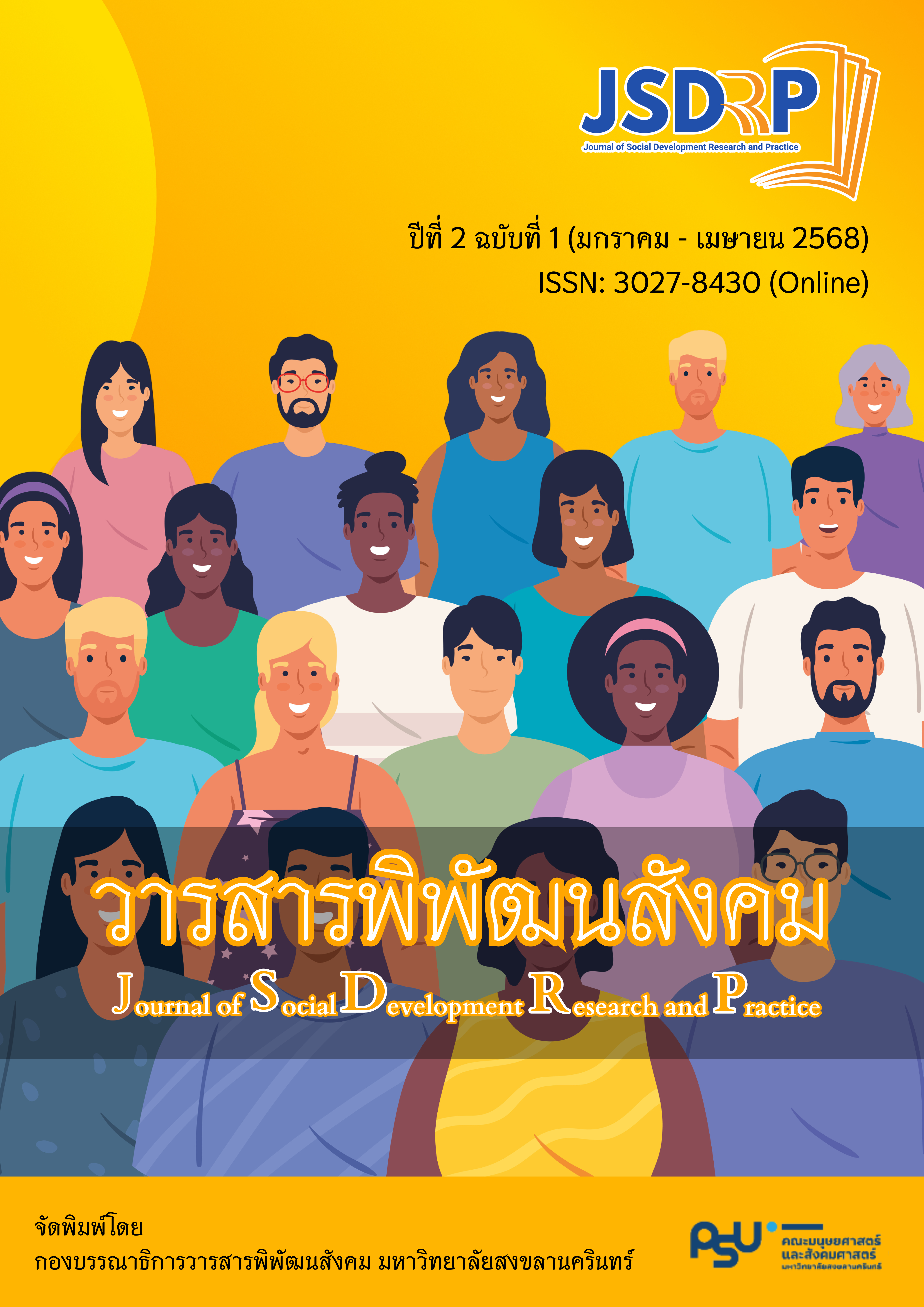The Relationship Between Peer Alcohol Use and Alcohol Consumption Behavior: A Meta-Analysis of Research in Thailand
Keywords:
Meta-Analysis, Peer Alcohol Use, Consumption BehaviorAbstract
Purpose: This study analyzes a meta-analysis to derive reliable standard index values the intricate relationship between peer alcohol drinking and alcohol consumption behavior in Thailand from 2013 to 2022. Furthermore, it systematically compares the significant differences in these standard index values associated with the presence of peer alcohol use and various alcohol consumption behaviors across diverse research characteristic variables.
Methodology: A meta-analysis was conducted using the methods of Rosenthal & Hedges, focusing on a population of 19 research studies selected through the PRISMA 2020 process. The studies were chosen for their sufficient statistical values for meta-analysis and underwent quality assessment. The research tools included a quality assessment questionnaire and a summary of research characteristics that were validated for content validity. Data was analyzed using Jamovi, MAJOR-Meta-Analysis for JAMOVI, and R software.
Findings: Most of the studies were published between 2018 and 2022. The meta-analysis results indicated variability in findings across the research reports, with no evidence of publication bias. The standard index values revealed a positive relationship between having drinking companions and alcohol consumption behavior (r = .40, p < .001). Additionally, no significant differences were found in the standard index values based on various research characteristic variables.
Applications of this study: The research findings indicate that an increase in the number of drinking companions correlates with a rise in alcohol consumption behavior. Therefore, to encourage a reduction in alcohol consumption among the Thai population in line with the National Alcohol Control Action Plan Phase 2, efforts can be made to minimize or eliminate the use of alcoholic beverages at social gatherings and promote activities that do not involve alcohol.
References
ชิษยรัสย์ ศิริไปล์. (2565). การวิเคราะห์ตัวบทภาพตัวแทนสัญญะความเป็นชายบนสื่อโฆษณาออนไลน์ของเครื่องดื่มแอลกอฮอล์ในสังคมไทย. วารสารวิจัยและนวัตกรรม สถาบันการอาชีวศึกษา กรุงเทพมหานคร, 5(1), 220-237.
ณกร ลูกสยาม, นันทิยา วัฒายุ และดวงใจ รัตนธัญญ. (2562). ปัจจัยทำนายพฤติกรรมการดื่มเครื่องดื่ม แอลกอฮอล์ในนักเรียนวัยรุ่นในเขตเทศบาล จังหวัดสุรินทร์. วารสารการพยาบาลและการดูแลสุขภาพ, 37(4), 22-31.
นงลักษณ์ วิรัชชัย. (2542). การวิเคราะห์อภิมาน. กรุงเทพฯ: จุฬาลงกรณ์มหาวิทยาลัย.
ปุณิกา อภิรักษ์ไกรศรี. (2565). วิถีการดื่มเครื่องดื่มแอลกอฮอล์ของแรงงานหญิง. วารสาร มจร การพัฒนาสังคม, 7(1), 29-41.
เพชรรัตน์ กิจสนาโยธิน. (2564). การศึกษาพฤติกรรมการบริโภคเครื่องดื่มแอลกอฮอล์ ผลกระทบจากการดื่มแอลกอฮอล์ และคุณภาพชีวิตของประชาชนจังหวัดสุโขทัย. วารสารวิจัยและพัฒนาระบบสุขภาพ, 14(3), 275-287.
แพรวพรรณ พรมยศ. (2564). ความสัมพันธ์ของความมั่นใจตนเองในการปฏิเสธการดื่มเครื่องดื่มแอลกอฮอล์กับพฤติกรรมการดื่มเครื่องดื่มแอลกอฮอล์ของนักศึกษาปริญญาตรี มหาวิทยาลัยราชภัฏมหาสารคาม ปีการศึกษา 2563. วารสารโรงพยาบาลมหาสารคาม, 18(2), 81-87.
วราภรณ์ วีระพันธ์. (2564). ปัจจัยที่มีความสัมพันธ์ต่อพฤติกรรมการดื่มแอลกอฮอล์ของนักเรียนมัธยมศึกษาตอนปลาย อำเภอซำสูง จังหวัดขอนแก่น. วารสารวิจัยและพัฒนาระบบสุขภาพ, 14(3), 166-178.
วราวุฒิ มหามิตร และอิสระพงศ์ ถนัดค้า. (2563). การรับรู้ ความตระหนักเกี่ยวกับกฎหมายควบคุมเครื่องดื่มแอลกอฮอล์และพฤติกรรมการดื่มเครื่องดื่มแอลกอฮอล์ของนักศึกษามหาวิทยาลัยราชภัฏชัยภูมิ อำเภอเมือง จังหวัดชัยภูมิ. วารสารสถาบันวิจัยและพัฒนา มหาวิทยาลัยราชภัฏชัยภูมิ, 2(1), 1-10.
สำนักเลขาธิการคณะรัฐมนตรี. (2565). แผนปฏิบัติการด้านควบคุมเครื่องดื่มแอลกอฮอล์ระดับชาติ ระยะที่ 2 (พ.ศ. 2565-2570). สืบค้นเมื่อ 26 สิงหาคม 2567 จาก https://resolution.soc.go.th/PDF_UPLOAD/2565/P_406951_1.pdf
สุจิตตา ฤทธิ์มนตรี, โสภิดา ดาวสดใส, ขวัญสุดา บุญทศ และศริญญา ชาญสุข. (2566). ผลกระทบจากการบริโภคเครื่องดื่มแอลกอฮอล์ของผู้อื่นตามการรับรู้ของเหยื่อ. วารสารการแพทย์โรงพยาบาลอุดรธานี, 31(1), 51-61.
สุวิมล สงกลาง และสุณีรัตน์ ยั่งยืน. (2563). ความสัมพันธ์ระหว่างปัจจัยสิ่งแวดล้อมทางสังคมกับการดื่มเครื่องดื่มที่มีแอลกอฮอล์ของวัยรุ่น. วารสารเครือข่ายวิทยาลัยพยาบาลและวิทยาลัยการสาธารณสุขภาคใต้, 7(1), 32-44.
อมร ตงศิริ, วุธิพงศ์ ภักดีกุล และวรินท์มาศ เกษทองมา. (2563). ปัจจัยที่มีความสัมพันธ์ต่อการดื่มเครื่องดื่มแอลกอฮอล์ของวัยรุ่นตอนต้น ในอำเภอพรรณานิคม จังหวัดสกลนคร. วารสารวิจัยและพัฒนาระบบสุขภาพ, 13(2), 560-571.
Ali, T., & Worku, T. (2020). Current alcohol consumption and associated factors among school adolescents and youths in Ethiopia: A systematic review and meta-analysis. SAGE Open Medicine, 8.
Cooper, H., Hedges, L.V., & Valentine, J. C. (2019). The handbook of research synthesis and meta-analysis (3rd edition). New York: Russell Sage Foundation.
Flay, B.R., & Petraitis, J. (1994). The theory of triadic influence: a new theory of health behavior with implications for preventive interventions. Advances in Medical Sociology, 4, 19-44.
Ivaniushina, V., & Titkova, V. (2021). Peer influence in adolescent drinking behavior: A meta-analysis of stochastic actor-based modeling studies. Retrieved 20 June 2024, from https://journals.plos.org/plosone/articleid=10.1371/journal.pone.0250169
Jokinen, T., Alexander, E.C., Manikam, L., Huq, T., Patil, P., Benjumea, D., Das, I., & Davidson, L.L. (2021). A systematic review of household and family alcohol use and adolescent behavioural outcomes in low- and middle-income countries. Child Psychiatry & Human Development, 52(4), 554-570.
Karaye, I.M., Maleki, N., Hassan, N., & Yunusa, I. (2023). Trends in Alcohol-Related Deaths by Sex in the US, 1999-2020. Retrieved 20 June 2024, from https://jamanetwork.com/journals/jamanetworkopen/fullarticle/2807706
Matthay, E.C., Hagan, E., Gottlieb, L.M., Tan, M.L., Vlahov, D., Adler, N., & Glymour, M.M. (2021). Powering population health research: Considerations for plausible and actionable effect sizes. SSM - Population Health, 14, 1-9.
Page, M.J. et al. (2021). The PRISMA 2020 statement: an updated guideline for reporting systematic reviews. BMJ, 372(71), 1-9.
R Core Team. (2021). R: A language and environment for statistical computing (Version 4.0) [Computer software]. Retrieved 20 May 2024, from https://cran.r-project.org
Schaefer, D.R., Van Woerden, I., Hruschka, D., & Bruening, M. (2021). Finding and Keeping Friends in College and Their Influence on Alcohol Use: A Network Analysis. Journal of Studies on Alcohol and Drugs, 82(1), 121–131.
The Jamovi Project. (2024). Jamovi (Version 2.5) [Computer Software]. Retrieved 20 June 2024, from https://www.jamovi.org
Tongsamsi, K., & Tongsamsi, I. (2018). Domestic violence resulting from alcohol use: An analysis of reports from Thai daily newspapers during 2006-2015. Nida Development Journal, 58(2), 148-167.
Wilson, D.B. (2017). Formulas used by the “practical meta-analysis effect size calculator”. George Mason University. Retrieved 18 June 2024, from https://www.campbellcollaboration.org/escalc/equations.php
Wilson, D.B. (2023). Practical meta-analysis effect size calculator (Version 2023.11.27). Retrieved 18 June 2024, from https://www.campbellcollaboration.org/escalc
Wilson, M.N., Langille, D.B., Ogilvie, R., & Asbridge, M. (2018). When parents supply alcohol to their children: Exploring associations with drinking frequency, alcohol-related harms, and the role of parental monitoring. Drug and Alcohol Dependence, 183, 141-149.
Zhao, X. et al. (2020). Intention to drink and alcohol use before 18 years among Australian adolescents: An extended Theory of Planned Behavior. Addictive Behaviors, 111.
Downloads
Published
How to Cite
Issue
Section
License
Copyright (c) 2025 Journal of Social Development Research and Practice

This work is licensed under a Creative Commons Attribution-NonCommercial-NoDerivatives 4.0 International License.
This work is licensed under a Creative Commons Attribution-NonCommercial-NoDerivatives 4.0 International License.





